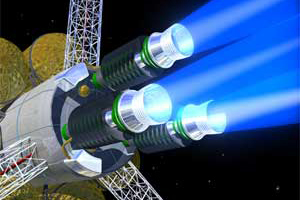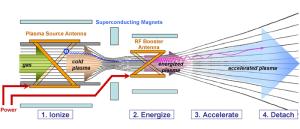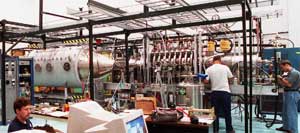Commercially Developed Plasma Engine Soon to be Tested in Space
DailyTech – Commercially Developed Plasma Engine Soon to be Tested in Space
New Vasimir engine could cut Mars travel to 60-70 days, allow greater rocket fuel economy
The new rocket is named Variable Specific Impulse Magnetoplasma Rocket (VASIMR). A traditional rocket can produce a specific impulse of around 450 seconds, or in other words 1 pound of thrust from 1 pound of fuel for 450 seconds. VASIMR can produce several times this amount, cutting a trip to Mars from 6 to 9 months with conventional rockets down to a mere 2 to 3 months. It could do this by being able to burn fuel continuously the whole trip accelerating on the first half of the journey to Mars and decelerating on the second leg of the journey, preparing to enter orbit.
The rocket consists of three critical units or cells. The first is the plasma generator. It sits deepest into the rocket and consists of a generator which ionizes heated light gases such as hydrogen, creating plasma — atoms stripped of their electrons. The plasma, at a modest temperature of 10,000 °C, is then pumped into the second unit, the amplifier. In the amplifier cell the plasma is blasted with electromagnetic waves via radio waves. These waves heat the plasma burning hot similar to how food is heated in a microwave. Finally the ultra-hot plasma is channeled in magnetic containment fields to the final cell, the magnetic nozzle. This nozzle is the critical control which controls how much fuel exits, and how fast the exiting plasma is going.
The nozzle also protects the spacecraft from the burning hot plasma. How hot is the plasma exactly?? Well, early estimates are that it will be around 180 million degrees Fahrenheit (100 million degrees Celsius), only about 25,000 times hotter than the burning gases exiting the space shuttle. However, thanks to the magnetic nozzle the plasma can be tamed and channeled into useful impulse.
Dr. Chang-Diaz explains, “Rockets tend to work much better the hotter the exhaust is and the plasma allows you to go to temperatures millions of degrees rather than thousands of degrees in a conventional rocket engine.”




Recent Comments